engine coolant CHRYSLER ASPEN 2008 2.G User Guide
[x] Cancel search | Manufacturer: CHRYSLER, Model Year: 2008, Model line: ASPEN, Model: CHRYSLER ASPEN 2008 2.GPages: 479, PDF Size: 4.3 MB
Page 405 of 479
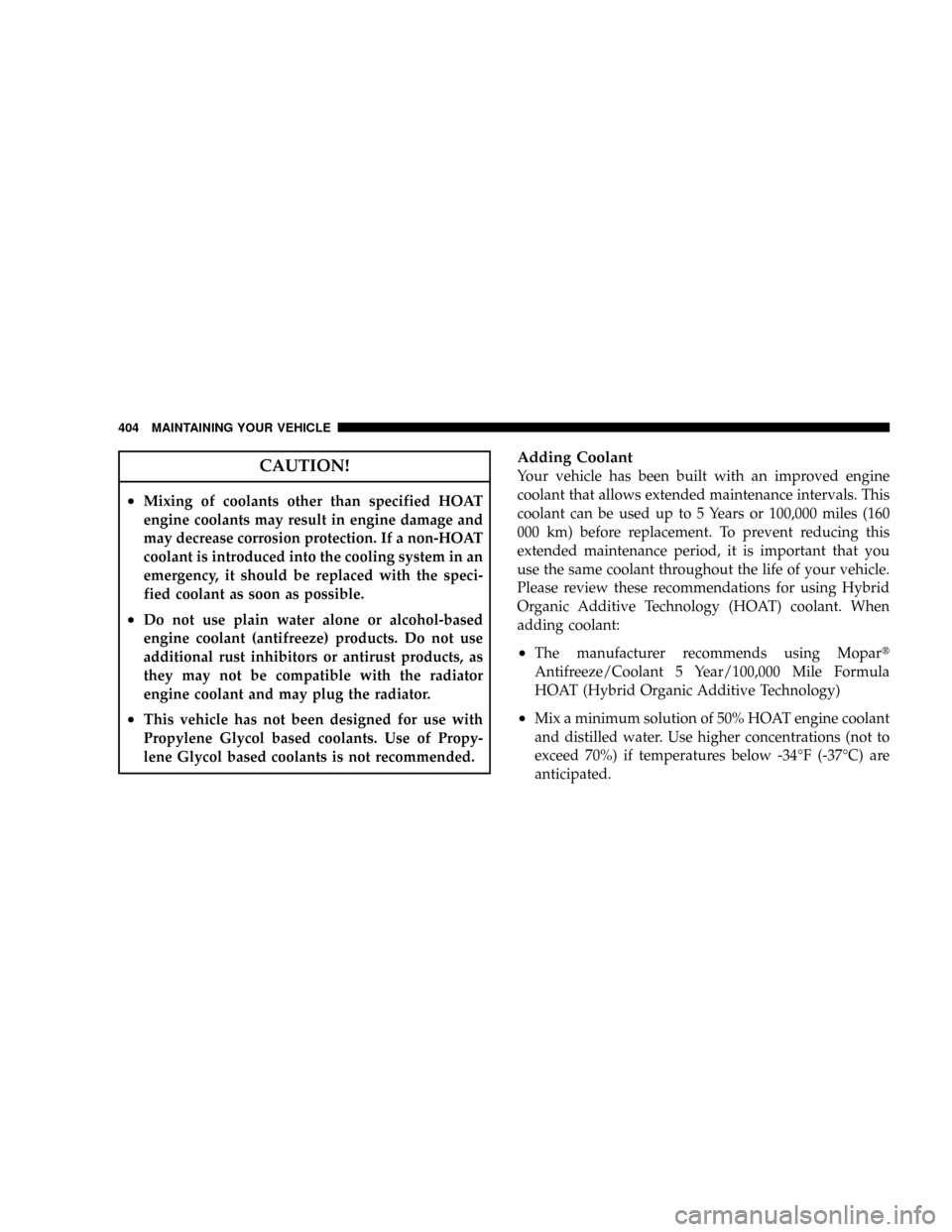
CAUTION!
²Mixing of coolants other than specified HOAT
engine coolants may result in engine damage and
may decrease corrosion protection. If a non-HOAT
coolant is introduced into the cooling system in an
emergency, it should be replaced with the speci-
fied coolant as soon as possible.
²Do not use plain water alone or alcohol-based
engine coolant (antifreeze) products. Do not use
additional rust inhibitors or antirust products, as
they may not be compatible with the radiator
engine coolant and may plug the radiator.
²This vehicle has not been designed for use with
Propylene Glycol based coolants. Use of Propy-
lene Glycol based coolants is not recommended.
Adding Coolant
Your vehicle has been built with an improved engine
coolant that allows extended maintenance intervals. This
coolant can be used up to 5 Years or 100,000 miles (160
000 km) before replacement. To prevent reducing this
extended maintenance period, it is important that you
use the same coolant throughout the life of your vehicle.
Please review these recommendations for using Hybrid
Organic Additive Technology (HOAT) coolant. When
adding coolant:
²The manufacturer recommends using Mopart
Antifreeze/Coolant 5 Year/100,000 Mile Formula
HOAT (Hybrid Organic Additive Technology)
²Mix a minimum solution of 50% HOAT engine coolant
and distilled water. Use higher concentrations (not to
exceed 70%) if temperatures below -34ÉF (-37ÉC) are
anticipated.
404 MAINTAINING YOUR VEHICLE
Page 406 of 479
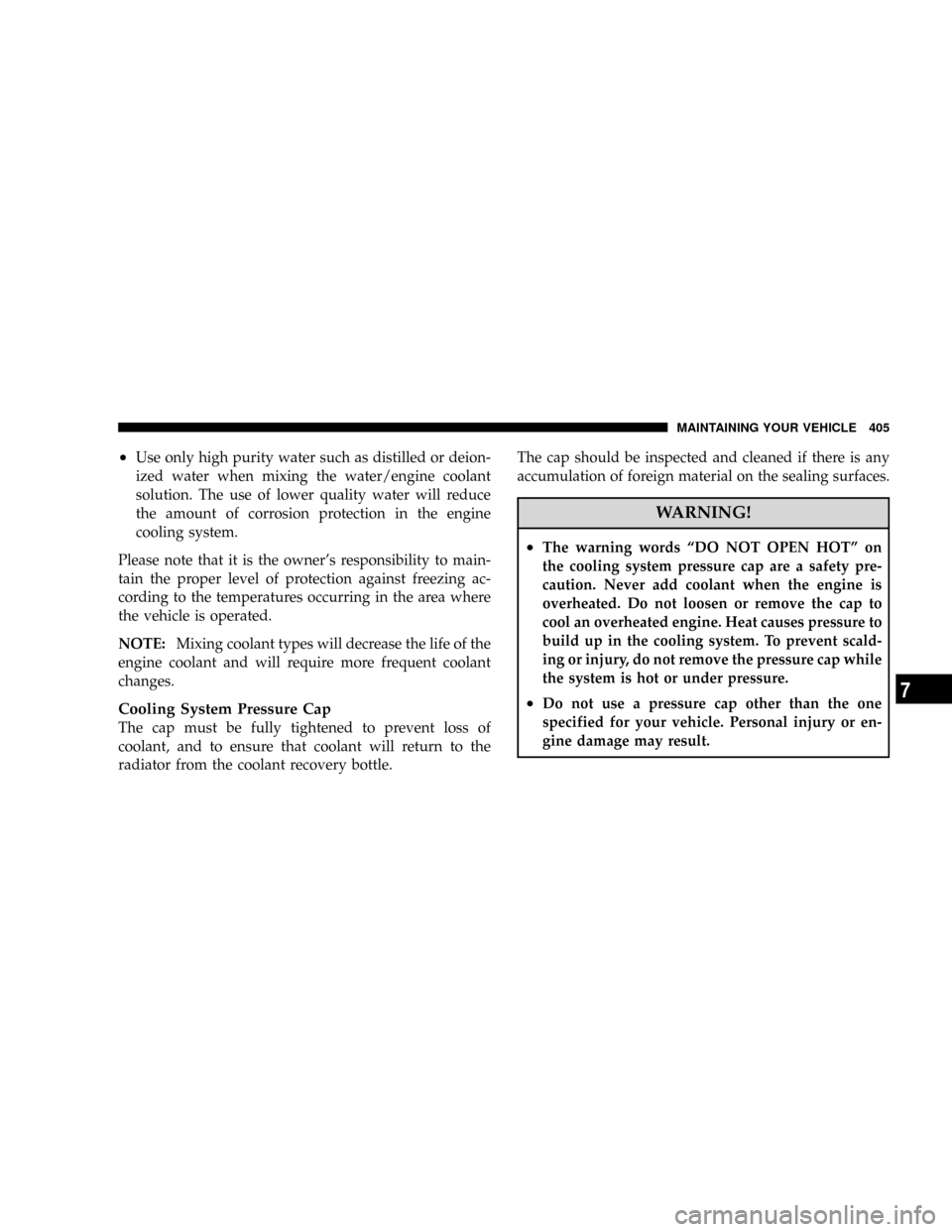
²Use only high purity water such as distilled or deion-
ized water when mixing the water/engine coolant
solution. The use of lower quality water will reduce
the amount of corrosion protection in the engine
cooling system.
Please note that it is the owner's responsibility to main-
tain the proper level of protection against freezing ac-
cording to the temperatures occurring in the area where
the vehicle is operated.
NOTE:Mixing coolant types will decrease the life of the
engine coolant and will require more frequent coolant
changes.
Cooling System Pressure Cap
The cap must be fully tightened to prevent loss of
coolant, and to ensure that coolant will return to the
radiator from the coolant recovery bottle.The cap should be inspected and cleaned if there is any
accumulation of foreign material on the sealing surfaces.
WARNING!
²The warning words ªDO NOT OPEN HOTº on
the cooling system pressure cap are a safety pre-
caution. Never add coolant when the engine is
overheated. Do not loosen or remove the cap to
cool an overheated engine. Heat causes pressure to
build up in the cooling system. To prevent scald-
ing or injury, do not remove the pressure cap while
the system is hot or under pressure.
²Do not use a pressure cap other than the one
specified for your vehicle. Personal injury or en-
gine damage may result.
MAINTAINING YOUR VEHICLE 405
7
Page 407 of 479
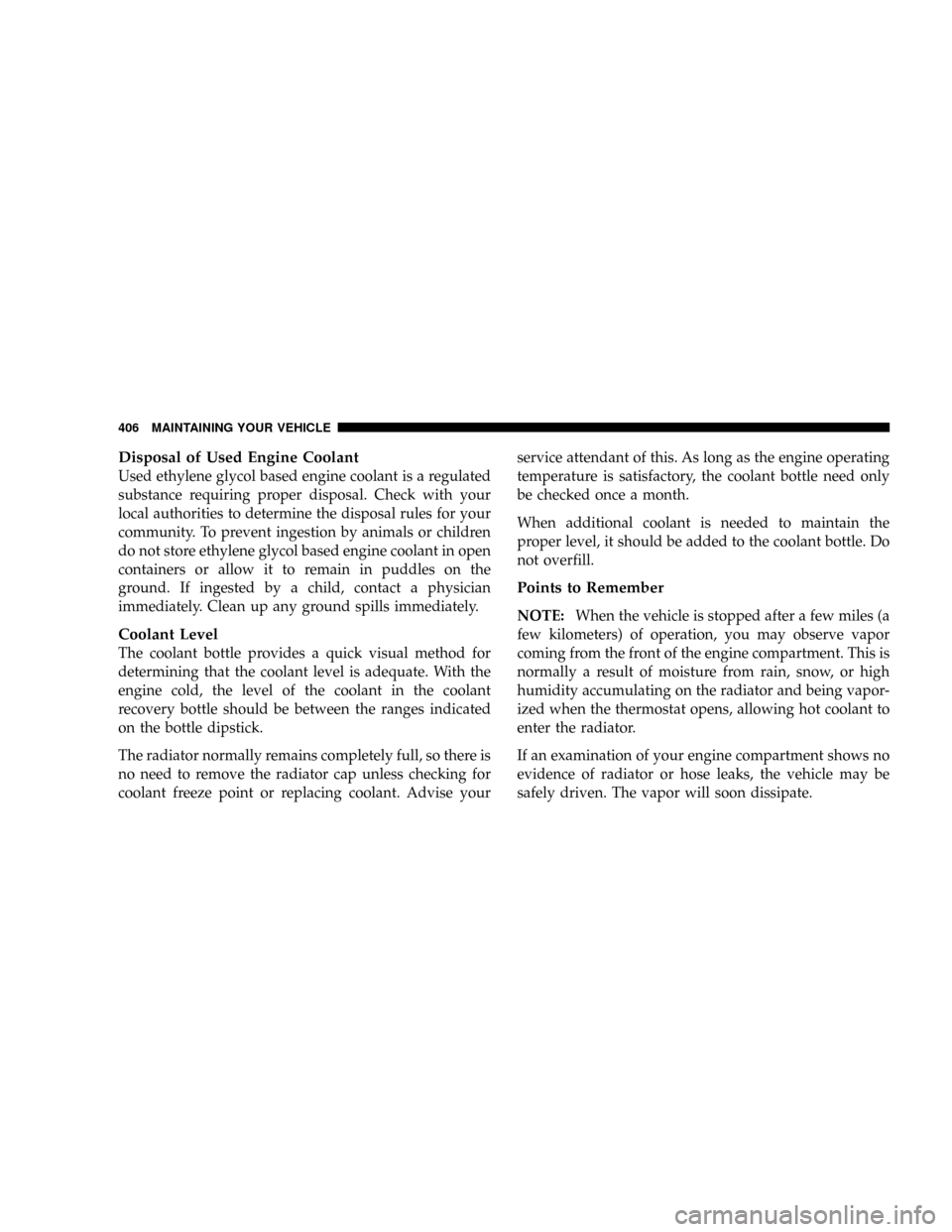
Disposal of Used Engine Coolant
Used ethylene glycol based engine coolant is a regulated
substance requiring proper disposal. Check with your
local authorities to determine the disposal rules for your
community. To prevent ingestion by animals or children
do not store ethylene glycol based engine coolant in open
containers or allow it to remain in puddles on the
ground. If ingested by a child, contact a physician
immediately. Clean up any ground spills immediately.
Coolant Level
The coolant bottle provides a quick visual method for
determining that the coolant level is adequate. With the
engine cold, the level of the coolant in the coolant
recovery bottle should be between the ranges indicated
on the bottle dipstick.
The radiator normally remains completely full, so there is
no need to remove the radiator cap unless checking for
coolant freeze point or replacing coolant. Advise yourservice attendant of this. As long as the engine operating
temperature is satisfactory, the coolant bottle need only
be checked once a month.
When additional coolant is needed to maintain the
proper level, it should be added to the coolant bottle. Do
not overfill.
Points to Remember
NOTE:When the vehicle is stopped after a few miles (a
few kilometers) of operation, you may observe vapor
coming from the front of the engine compartment. This is
normally a result of moisture from rain, snow, or high
humidity accumulating on the radiator and being vapor-
ized when the thermostat opens, allowing hot coolant to
enter the radiator.
If an examination of your engine compartment shows no
evidence of radiator or hose leaks, the vehicle may be
safely driven. The vapor will soon dissipate.
406 MAINTAINING YOUR VEHICLE
Page 408 of 479
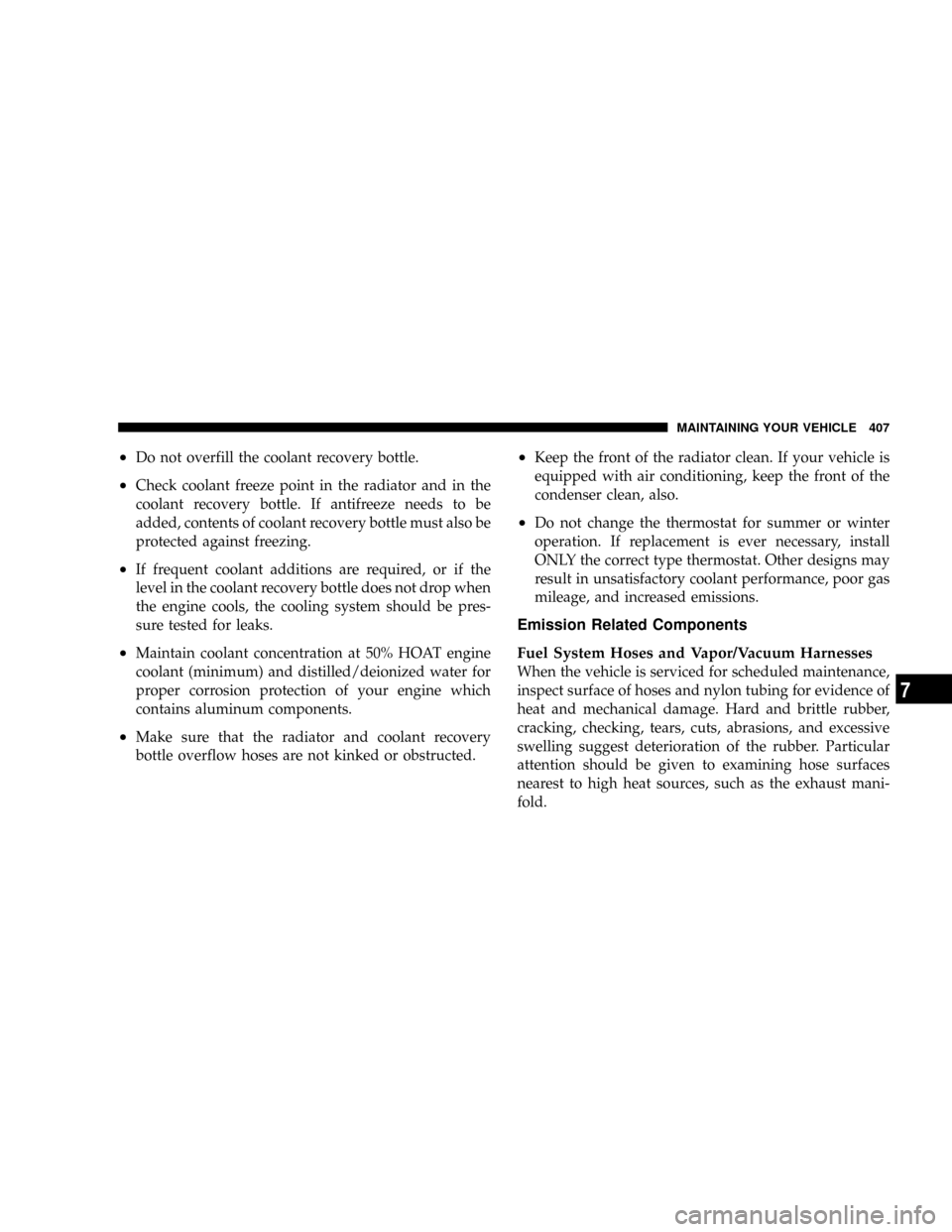
²Do not overfill the coolant recovery bottle.
²Check coolant freeze point in the radiator and in the
coolant recovery bottle. If antifreeze needs to be
added, contents of coolant recovery bottle must also be
protected against freezing.
²If frequent coolant additions are required, or if the
level in the coolant recovery bottle does not drop when
the engine cools, the cooling system should be pres-
sure tested for leaks.
²Maintain coolant concentration at 50% HOAT engine
coolant (minimum) and distilled/deionized water for
proper corrosion protection of your engine which
contains aluminum components.
²Make sure that the radiator and coolant recovery
bottle overflow hoses are not kinked or obstructed.
²Keep the front of the radiator clean. If your vehicle is
equipped with air conditioning, keep the front of the
condenser clean, also.
²Do not change the thermostat for summer or winter
operation. If replacement is ever necessary, install
ONLY the correct type thermostat. Other designs may
result in unsatisfactory coolant performance, poor gas
mileage, and increased emissions.
Emission Related Components
Fuel System Hoses and Vapor/Vacuum Harnesses
When the vehicle is serviced for scheduled maintenance,
inspect surface of hoses and nylon tubing for evidence of
heat and mechanical damage. Hard and brittle rubber,
cracking, checking, tears, cuts, abrasions, and excessive
swelling suggest deterioration of the rubber. Particular
attention should be given to examining hose surfaces
nearest to high heat sources, such as the exhaust mani-
fold.
MAINTAINING YOUR VEHICLE 407
7
Page 437 of 479

FLUIDS AND CAPACITIES
U.S. Metric
Fuel
4.7L, 87 Octane 27 gal 102 L
5.7L, 89 Octane 27 gal 102 L
Engine Oil (with filter)
4.7L, SAE 5W-20, API Certified 6 qts 5.7 L
5.7L, SAE 5W-20, API Certified 7 qts 6.6 L
Cooling System (includes 2.1 qts/2 L for coolant bottle
4.7L (MopartAntifreeze/Coolant 5 Year/100,000 Mile
Formula)14.2 qts 13.5 L
5.7L (MopartAntifreeze/Coolant 5 Year/100,000 Mile
Formula)16.6 qts 15.8 L
NOTE:All fluid capacities are approximate.
436 MAINTAINING YOUR VEHICLE
Page 438 of 479

FLUIDS, LUBRICANTS AND GENUINE PARTS
Engine
Component Fluids, Lubricants and Genuine Parts
Engine Coolant MopartAntifreeze/Coolant 5 Year/100,000 Mile Formula HOAT (Hybrid Or-
ganic Additive Technology).
4.7L/5.7L Engine Oil Use API Certified SAE 5W-20 Engine Oil, meeting the requirements of
DaimlerChrysler Material Standard MS-6395. Refer to your engine oil filler
cap for correct SAE grade.
Engine Oil Filter MopartEngine Oil Filter, P/N 5281090 or equivalent.
Spark Plugs (4.7L Engine) Upper Bank Ð FR8TE2 (Gap 0.039 in [.99 mm]) Lower Bank Ð FR8T1332
(Gap 0.051 in [1.30 mm])
Spark Plugs (5.7L Engine) REC14MCC4 (Gap 0.043 in [1.09 mm])
Fuel Selection (4.7L Engine) 87 Octane
Fuel Selection (5.7L Engine) 87 Octane Acceptable - 89 Octane Recommended
MAINTAINING YOUR VEHICLE 437
7
Page 442 of 479
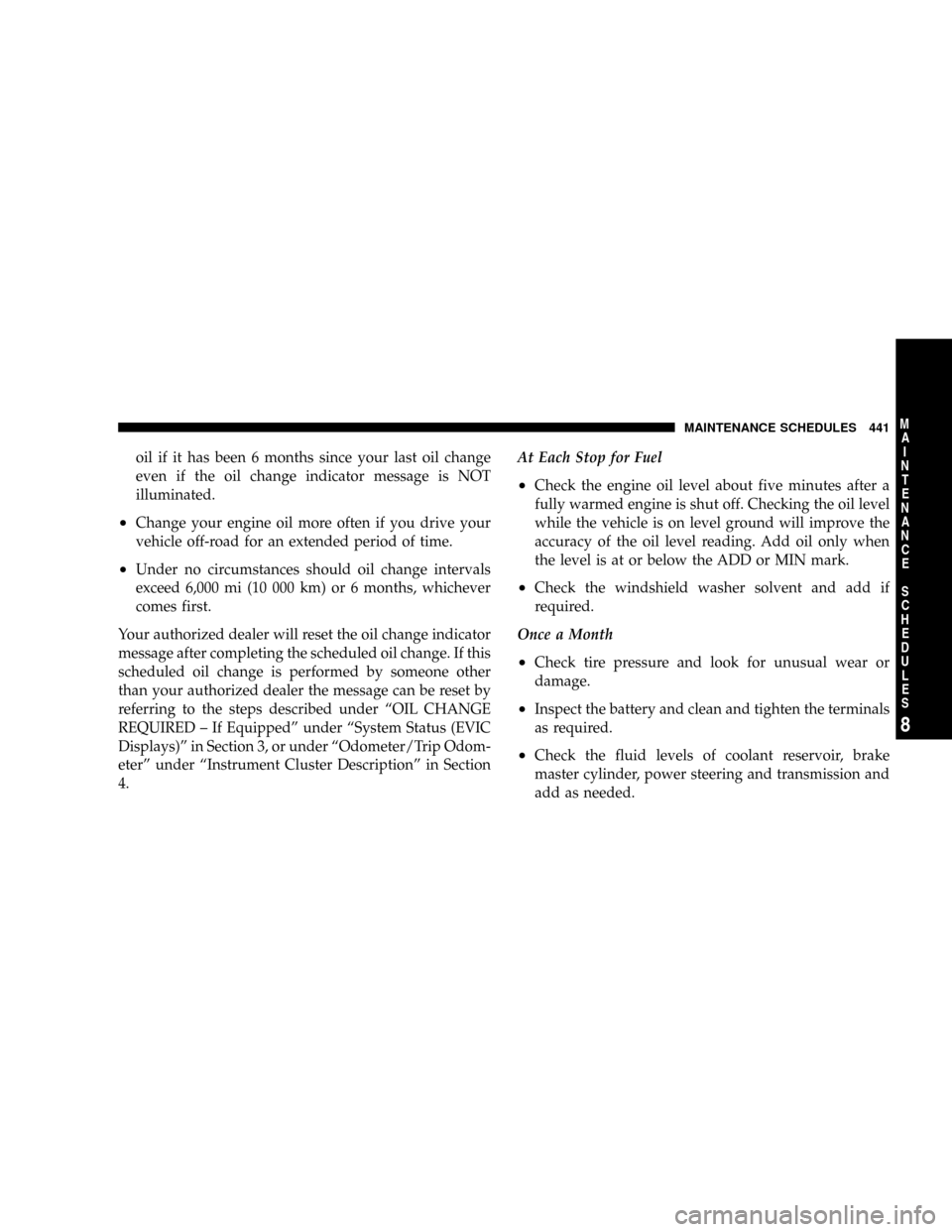
oil if it has been 6 months since your last oil change
even if the oil change indicator message is NOT
illuminated.
²Change your engine oil more often if you drive your
vehicle off-road for an extended period of time.
²Under no circumstances should oil change intervals
exceed 6,000 mi (10 000 km) or 6 months, whichever
comes first.
Your authorized dealer will reset the oil change indicator
message after completing the scheduled oil change. If this
scheduled oil change is performed by someone other
than your authorized dealer the message can be reset by
referring to the steps described under ªOIL CHANGE
REQUIRED ± If Equippedº under ªSystem Status (EVIC
Displays)º in Section 3, or under ªOdometer/Trip Odom-
eterº under ªInstrument Cluster Descriptionº in Section
4.At Each Stop for Fuel
²Check the engine oil level about five minutes after a
fully warmed engine is shut off. Checking the oil level
while the vehicle is on level ground will improve the
accuracy of the oil level reading. Add oil only when
the level is at or below the ADD or MIN mark.
²Check the windshield washer solvent and add if
required.
Once a Month
²Check tire pressure and look for unusual wear or
damage.
²Inspect the battery and clean and tighten the terminals
as required.
²Check the fluid levels of coolant reservoir, brake
master cylinder, power steering and transmission and
add as needed.
MAINTENANCE SCHEDULES 441
8
M
A
I
N
T
E
N
A
N
C
E
S
C
H
E
D
U
L
E
S
Page 445 of 479

Perform Maintenance Every(Where time and mileage
are listed, follow the interval that occurs first.)
Maintenance Items Miles Kilometers or Months
Replace the engine air cleaner filter. 30,000 50 000 30
Inspect the transfer case fluid. 30,000 50 000 30
Replace the top row of spark plugs on 4.7L engines. **30,000 50 000 30
Replace the spark plugs on 3.7L and 5.7L engines.30,000 50 000 30
Change the automatic transmission fluid & filter if using
your vehicle for any of the following: police, taxi, fleet or
frequent trailer towing.60,000 100 000 60
Change the transfer case fluid if using your vehicle for
any of the following: police, taxi, fleet, off-road or fre-
quent trailer towing.60,000 100 000 60
Inspect and replace PCV valve if necessary. 90,000 150 000 90
Flush and replace the engine coolant. 102,000 170 000 60
Replace the ignition cables on 4.7L engines.102,000 170 000 102
Replace the side row of spark plugs on 4.7L engines. **102,000 170 000 102
444 MAINTENANCE SCHEDULES
8
M
A
I
N
T
E
N
A
N
C
E
S
C
H
E
D
U
L
E
S
Page 459 of 479
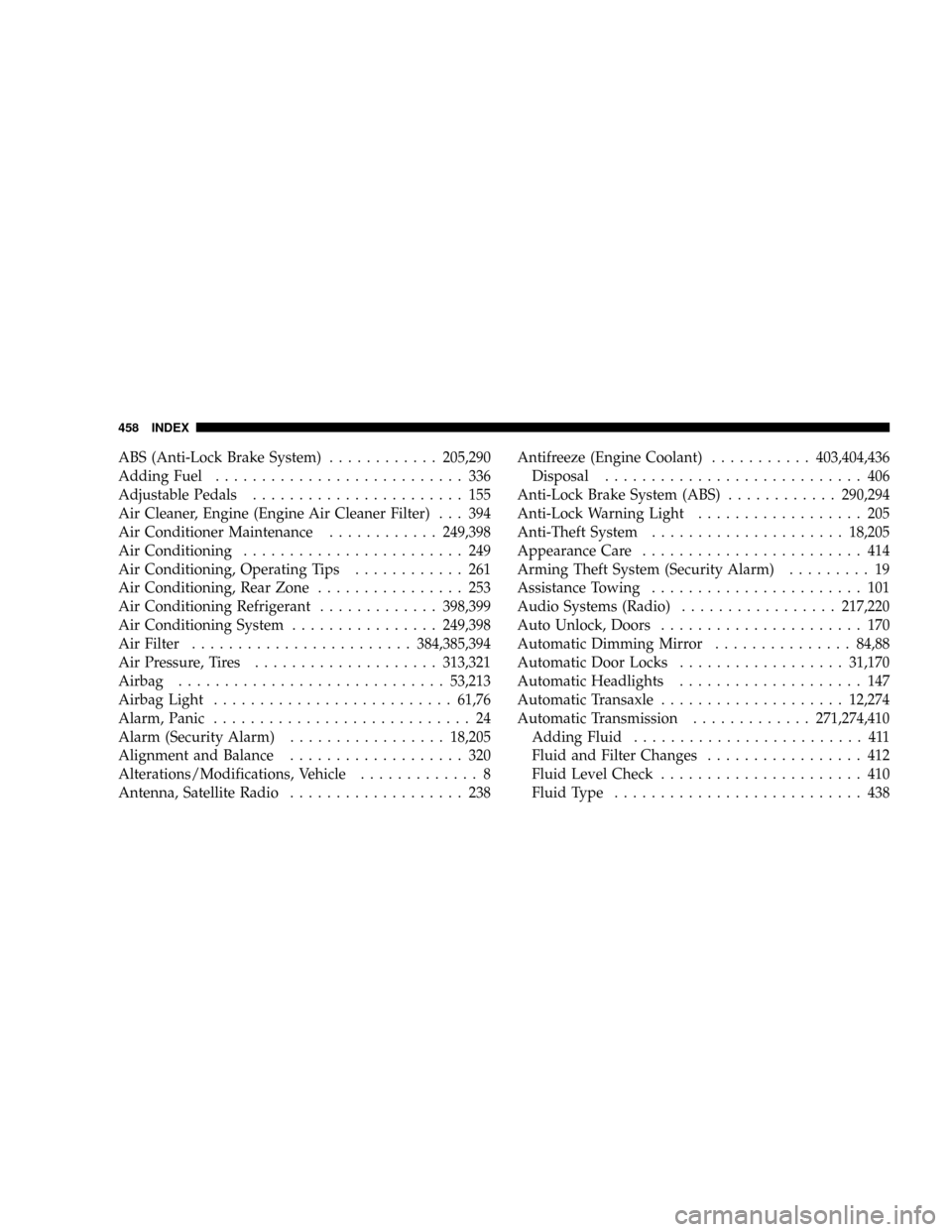
ABS (Anti-Lock Brake System)............205,290
Adding Fuel........................... 336
Adjustable Pedals....................... 155
Air Cleaner, Engine (Engine Air Cleaner Filter) . . . 394
Air Conditioner Maintenance............249,398
Air Conditioning........................ 249
Air Conditioning, Operating Tips............ 261
Air Conditioning, Rear Zone................ 253
Air Conditioning Refrigerant.............398,399
Air Conditioning System................249,398
Air Filter........................384,385,394
Air Pressure, Tires....................313,321
Airbag.............................53,213
Airbag Light..........................61,76
Alarm, Panic............................ 24
Alarm (Security Alarm).................18,205
Alignment and Balance................... 320
Alterations/Modifications, Vehicle............. 8
Antenna, Satellite Radio................... 238Antifreeze (Engine Coolant)...........403,404,436
Disposal............................ 406
Anti-Lock Brake System (ABS)............290,294
Anti-Lock Warning Light.................. 205
Anti-Theft System.....................18,205
Appearance Care........................ 414
Arming Theft System (Security Alarm)......... 19
Assistance Towing....................... 101
Audio Systems (Radio).................217,220
Auto Unlock, Doors...................... 170
Automatic Dimming Mirror...............84,88
Automatic Door Locks..................31,170
Automatic Headlights.................... 147
Automatic Transaxle....................12,274
Automatic Transmission.............271,274,410
Adding Fluid......................... 411
Fluid and Filter Changes................. 412
Fluid Level Check...................... 410
Fluid Type........................... 438
458 INDEX
Page 461 of 479
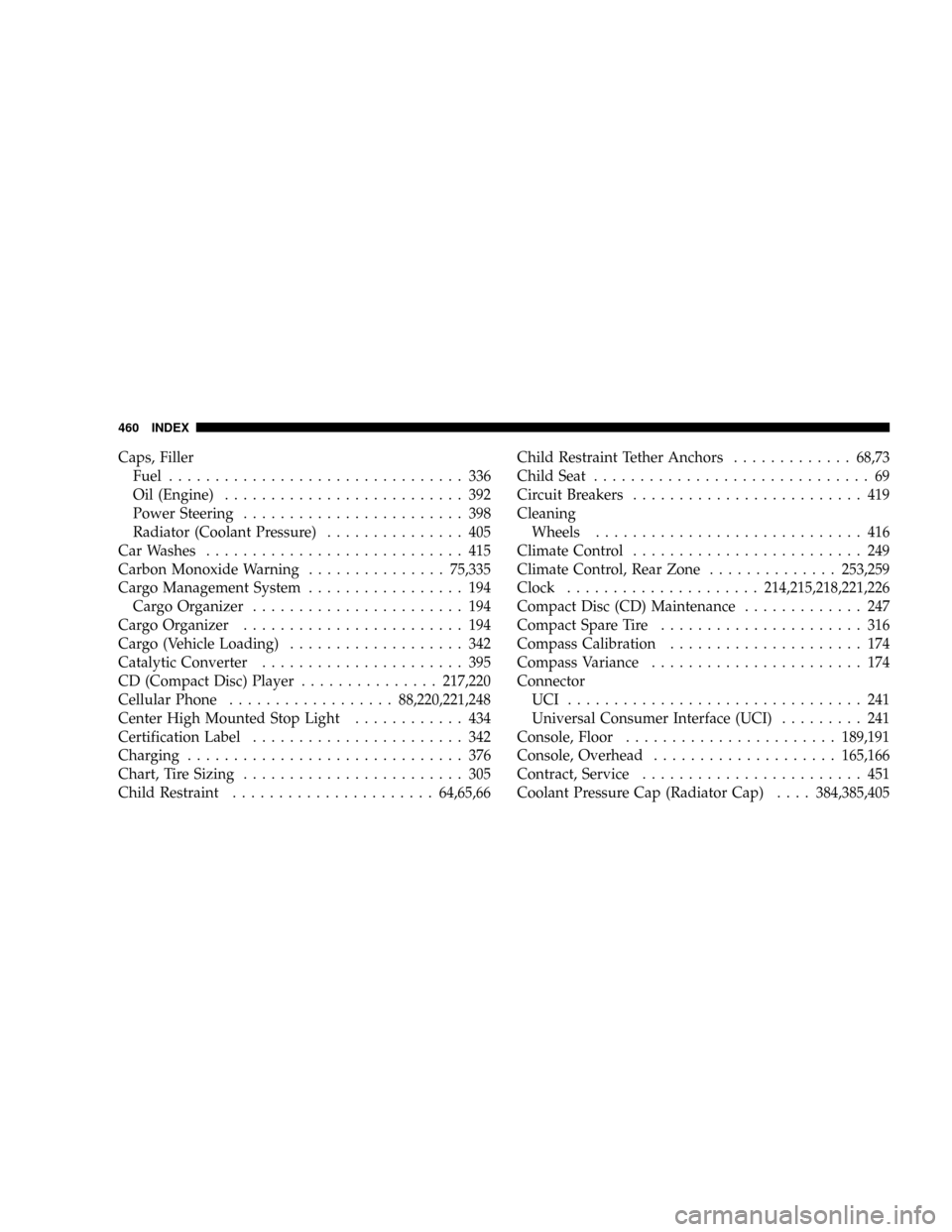
Caps, Filler
Fuel................................ 336
Oil (Engine).......................... 392
Power Steering........................ 398
Radiator (Coolant Pressure)............... 405
Car Washes............................ 415
Carbon Monoxide Warning...............75,335
Cargo Management System................. 194
Cargo Organizer....................... 194
Cargo Organizer........................ 194
Cargo (Vehicle Loading)................... 342
Catalytic Converter...................... 395
CD (Compact Disc) Player...............217,220
Cellular Phone..................88,220,221,248
Center High Mounted Stop Light............ 434
Certification Label....................... 342
Charging.............................. 376
Chart, Tire Sizing........................ 305
Child Restraint......................64,65,66Child Restraint Tether Anchors.............68,73
Child Seat.............................. 69
Circuit Breakers......................... 419
Cleaning
Wheels............................. 416
Climate Control......................... 249
Climate Control, Rear Zone..............253,259
Clock.....................214,215,218,221,226
Compact Disc (CD) Maintenance............. 247
Compact Spare Tire...................... 316
Compass Calibration..................... 174
Compass Variance....................... 174
Connector
UCI ................................ 241
Universal Consumer Interface (UCI)......... 241
Console, Floor.......................189,191
Console, Overhead....................165,166
Contract, Service........................ 451
Coolant Pressure Cap (Radiator Cap)....384,385,405
460 INDEX